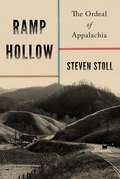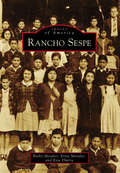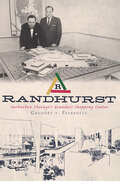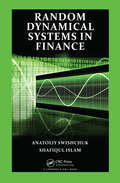- Table View
- List View
Raj Kapoor: The Socialist Showman
by Geoffrey G. Jones Snigdha SurThis case examines the career of Raj Kapoor, the legendary Bollywood filmmaker of the postwar decades. It explores how Kapoor built RK studios after 1948 by releasing a series of movies that combined romance with social messages focused on the fate of the common man in a world of social injustice. The case discusses how women were depicted in Kapoor's films and enables a discussion of the role of cinema in propagating gender stereotypes and contributing to the challenges faced by women in rural India today. The case also explores the huge success of Kapoor's films in the Soviet Union and elsewhere in the Communist world. During the postwar decades there were two global worlds. In the Western world, Hollywood provided a stream of cinematic entertainment. In the Communist world, Bollywood provided the same service. They each provided alternative visions of the world.
Raj Kapoor: The Socialist Showman
by Geoffrey G. Jones Snigdha SurThis case examines the career of Raj Kapoor, the legendary Bollywood filmmaker of the postwar decades. It explores how Kapoor built RK studios after 1948 by releasing a series of movies that combined romance with social messages focused on the fate of the common man in a world of social injustice. The case discusses how women were depicted in Kapoor's films and enables a discussion of the role of cinema in propagating gender stereotypes and contributing to the challenges faced by women in rural India today. The case also explores the huge success of Kapoor's films in the Soviet Union and elsewhere in the Communist world. During the postwar decades there were two global worlds. In the Western world, Hollywood provided a stream of cinematic entertainment. In the Communist world, Bollywood provided the same service. They each provided alternative visions of the world.
Raj Rhapsodies: Tourism Heritage And The Seduction Of History (New Directions in Tourism Analysis)
by Carol E. Henderson Maxine WeisgrauHeritage is a prized cultural commodity in the marketing of tourism destinations. Particular aspects of heritage are often more actively promoted, with others played down. The representation of heritage in tourism as static and timeless, derived since time immemorial from a distant past, is seductive. In Asia, a major part of the tourism market lies in the sale and consumption of highly orientalized images and versions of culture and history. In India’s marketing discourse, the state of Rajasthan symbolizes the nation in its heritage-laden, traditional and most authentic form. These images draw heavily on the British period in India - the Raj. In one sense, this vision of Rajasthan is ennobling, highlighting moments of cultural pride. In another sense, it demeans, by omitting and obscuring salient features of contemporary life. This fascinating book explores the cultural politics of tourism through interdisciplinary perspectives. Carol E. Henderson and Maxine Weisgrau demonstrate that tourism heritage privileges elite histories that recapitulate colonial relationships, compelling non-elites to collude in these narratives of subordination even as they advance their own alternative visions of history.
Rajat Gupta
by Paul M. Healy Eugene SoltesRajat Gupta, former managing director of McKinsey & Company, a director of Goldman Sachs, Proctor & Gamble, and AMR, and a well-known philanthropist, was convicted of engaging in insider trading. The case explores Gupta's rise and the later legal problems he faced.
Raksul
by Nobuo Sato Masahiro Kotosaka Akiko Kanno Scott Duke KominersRaksul, 2018 Forbes Japan "Startup of the Year," ran an e-commerce platform drawing upon thousands of individual suppliers. Launched as a business-to-business printing services marketplace, Raksul had recently expanded to operate both a logistics/delivery marketplace and a television advertising marketplace. Each marketplace faces its own growth challenges; at the same time, the CEO must consider whether and how each marketplace can enhance the others.
Rakuten
by F. Warren Mcfarlan Andrew Mcafee Thomas R. EisenmannRakuten, a native Japanese, e-commerce start-up and highly successful company, is expanding into new categories and new countries. It must figure out how to continue its trajectory of growth and profitability. A rewritten version of an earlier case.
Raleigh & Rosse: Measures to Motivate Exceptional Service
by Michael Mahoney Robert L. SimonsIn January 2010, U. S. luxury goods retailer Raleigh & Rosse is being sued by its employees for encouraging "off the clock" hours. At the center of the class action lawsuit is the famous Raleigh & Rosse performance measurement system previously thought to be the core of the retailer's success. The system uses a sales-per-hour model to reward salespeople for time well spent on the floor. However, in this industry, where strong customer service is essential, many sales representatives feel they are encouraged to spend time off the clock tending to client needs; this issue and others have led to consequences that the company did not envision. The case illustrates how rapid company growth, decentralized management, and unrelenting pressure to perform can distort performance measurement systems and lead to undesirable consequences.
Raleigh & Rosse: Measures to Motivate Exceptional Service
by Michael Mahoney Robert L. SimonsIn January 2010, U. S. luxury goods retailer Raleigh & Rosse is being sued by its employees for encouraging "off the clock" hours. At the center of the class action lawsuit is the famous Raleigh & Rosse performance measurement system previously thought to be the core of the retailer's success. The system uses a sales-per-hour model to reward salespeople for time well spent on the floor. However, in this industry, where strong customer service is essential, many sales representatives feel they are encouraged to spend time off the clock tending to client needs; this issue and others have led to consequences that the company did not envision. The case illustrates how rapid company growth, decentralized management, and unrelenting pressure to perform can distort performance measurement systems and lead to undesirable consequences.
Ramesh Patel at Aragon Entertainment Limited
by Anthony J. Mayo Joshua D. MargolisRamesh Patel, a high potential employee, was excited to be named to the company's New Horizons Board, a select team responsible for producing recommendations for new products or line extensions for Aragon Entertainment. Patel's co-worker and friend, Jeremy Gibson was also named to the Board, and the two were assigned to work together on a sub-taskforce. Patel was frustrated by Gibson's lack of effort and support on the taskforce and decides he must confront Gibson about his behavior.
Ramp Hollow: The Ordeal of Appalachia
by Steven Stoll<p>In Ramp Hollow, Steven Stoll offers a fresh, provocative account of Appalachia, and why it matters. He begins with the earliest European settlers, whose desire for vast forests to hunt in was frustrated by absentee owners―including George Washington and other founders―who laid claim to the region. Even as Daniel Boone became famous as a backwoods hunter and guide, the economy he represented was already in peril. Within just a few decades, Appalachian hunters and farmers went from pioneers to pariahs, from heroes to hillbillies, in the national imagination, and the area was locked into an enduring association with poverty and backwardness. Stoll traces these developments with empathy and precision, examining crucial episodes such as the Whiskey Rebellion, the founding of West Virginia, and the arrival of timber and coal companies that set off a devastating “scramble for Appalachia.” <p>At the center of Ramp Hollow is Stoll’s sensitive portrayal of Appalachian homesteads. Perched upon ridges and tucked into hollows, they combined small-scale farming and gardening with expansive foraging and hunting, along with distilling and trading, to achieve self-sufficiency and resist the dependence on cash and credit arising elsewhere in the United States. But the industrialization of the mountains shattered the ecological balance that sustained the households. Ramp Hollow recasts the story of Appalachia as a complex struggle between mountaineers and profit-seeking forces from outside the region. Drawing powerful connections between Appalachia and other agrarian societies around the world, Stoll demonstrates the vitality of a peasant way of life that mixes farming with commerce but is not dominated by a market mind-set. His original investigation, ranging widely from history to literature, art, and economics, questions our assumptions about progress and development, and exposes the devastating legacy of dispossession and its repercussions today.</p>
Rana Plaza (C): Primark and Victim Compensation
by John A. Quelch Margaret L. RodriguezOn April 24, 2013 the Rana Plaza factory building collapsed in Dhaka, the capital of Bangladesh. Over 1,100 people were killed in the worst industrial accident since the Union Carbide plant gas leak in Bhopal, India. Most of the victims worked for garment factories, whose primary clients were European, US and Canadian firms. Export contracts to such firms had helped Bangladesh become the world's second largest clothing exporter. Rana Plaza was not the first tragedy to occur in Bangladesh's garment industry, and without intervention, more might follow. International brand owners, domestic and foreign governments, labor unions and non-governmental organizations (NGOs), stepped up to discuss their responsibilities for improving conditions for Bangladeshi garment workers.
Rana Plaza: Workplace Safety in Bangladesh (A)
by John A. Quelch Margaret RodriguezOn April 24, 2013 the Rana Plaza factory building collapsed in Dhaka, the capital of Bangladesh. Over 1,100 people were killed in the worst industrial accident since the Union Carbide plant gas leak in Bhopal, India. Most of the victims worked for garment factories, whose primary clients were European, US and Canadian firms. Export contracts to such firms had helped Bangladesh become the world's second largest clothing exporter. Rana Plaza was not the first tragedy to occur in Bangladesh's garment industry, and without intervention, more might follow. International brand owners, domestic and foreign governments, labor unions and non-governmental organizations (NGOs), stepped up to discuss their responsibilities for improving conditions for Bangladeshi garment workers.
Rana Plaza: Workplace Safety in Bangladesh (A)
by John A. Quelch Margaret RodriguezOn April 24, 2013 the Rana Plaza factory building collapsed in Dhaka, the capital of Bangladesh. Over 1,100 people were killed in the worst industrial accident since the Union Carbide plant gas leak in Bhopal, India. Most of the victims worked for garment factories, whose primary clients were European, US and Canadian firms. Export contracts to such firms had helped Bangladesh become the world's second largest clothing exporter. Rana Plaza was not the first tragedy to occur in Bangladesh's garment industry, and without intervention, more might follow. International brand owners, domestic and foreign governments, labor unions and non-governmental organizations (NGOs), stepped up to discuss their responsibilities for improving conditions for Bangladeshi garment workers.
Rana Plaza: Workplace Safety in Bangladesh (B)
by John A. Quelch Margaret RodriguezIn the aftermath of the Rana Plaza building collapse, a group of international retailers and labor unions partnered to create a proposal for more stringent inspections and enforcement of safety standards in Bangladesh garment factories. The proposal was met by opposition from several U.S. firms, which claimed the proposal carried too a high a risk of litigation for them to sign. Neither proposal relied on legislation, but options for government involvement are also discussed in the case.
Ranching, Mining, and the Human Impact of Natural Resource Development
by Raymond L. GoldIn Ranching, Mining, and the Human Impact of Natural Resource Development, Raymond L. Gold observes and reports on people whose lives have been significantly affected by the industrialization of rural communities in the American West. Such community change research is rarely done, so this classic study is invaluable for its real world groundings applicable to a variety of social science theories. The study evolved out of ethnographic research on Western communities done over a full decade.This was the first work of its kind to examine and account for the rise of local citizens' groups on the sense of being a community. Its account of this process covers both ordinarily slow and extraordinarily rapid areas of change in the American West. In this regard it is a contribution to basic social theory, showing clearly the interrelation between small-community and large-society elements of the structure and functioning of community life. No other book brings together the story of social effects of natural resource development projects in the American West.This book shows how to implement a social policy concerning resource development and public agencies. It is intended for people interested in the environment, American society, rural and urban affairs, social impact assessment, and urban structures generally. It is also aimed at industrial and community planners and natural resource development firms.
Rancho Sespe (Images of America)
by Evie Ybarra Becky Morales Ernie MoralesIn 1833, Rancho Sespe began as a Mexican land grant with 8,881 acres stretching along the Santa Clara River from Piru to Santa Paula. The face of Rancho Sespe is not just the bunkhouse or the family housing that stood on this land; it is, rather, seen in the stories of those who lived and worked on the ranch. Their struggles and triumphs are shared in this book and illustrated with many vintage photographs. The Spaldings developed Rancho Sespe into a very successful ranch for citrus and livestock for over 30 years, and it became a quasi-feudal society as a self-contained working ranch in the 20th century. When the ranch later sold, it ushered in changes for Rancho Sespe to become a part of the modern age, and gone was the worker housing along with other remnants of the past. Many of the families continue to live in the surrounding area generation after generation.
Rand Fishkin at Moz (A)
by Thomas R. EisenmannIn 2016, senior management at Moz, a venture capital-backed startup providing software tools for digital marketing professionals, must decide how to address a looming cash flow crisis precipitated by failed efforts to broaden its product line. Seattle-based Moz had originally focused only on search engine optimization (SEO) software. Aiming to accelerate growth, over the past three years the startup had launched products targeted at content marketers, social media marketers, and small local businesses. Adoption of these new products had been disappointing, and the resource drain and distraction of launching them had reduced the growth of Moz's core SEO product. Management was wrestling with whether to either: 1) shut down or sell the new products; or 2) double down on the new products, funding further investment in them by selling the core SEO business or milking it as a "cash cow."
Rand Fishkin at Moz (B)
by Thomas R. EisenmannB case to 820002 In 2016, senior management at Moz, a venture capital-backed startup providing software tools for digital marketing professionals, must decide how to address a looming cash flow crisis precipitated by failed efforts to broaden its product line. Seattle-based Moz had originally focused only on search engine optimization (SEO) software. Aiming to accelerate growth, over the past three years the startup had launched products targeted at content marketers, social media marketers, and small local businesses. Adoption of these new products had been disappointing, and the resource drain and distraction of launching them had reduced the growth of Moz's core SEO product. Management was wrestling with whether to either: 1) shut down or sell the new products; or 2) double down on the new products, funding further investment in them by selling the core SEO business or milking it as a "cash cow."
Rand Fishkin at Moz (C)
by Thomas R. EisenmannC case to 820002 In 2016, senior management at Moz, a venture capital-backed startup providing software tools for digital marketing professionals, must decide how to address a looming cash flow crisis precipitated by failed efforts to broaden its product line. Seattle-based Moz had originally focused only on search engine optimization (SEO) software. Aiming to accelerate growth, over the past three years the startup had launched products targeted at content marketers, social media marketers, and small local businesses. Adoption of these new products had been disappointing, and the resource drain and distraction of launching them had reduced the growth of Moz's core SEO product. Management was wrestling with whether to either: 1) shut down or sell the new products; or 2) double down on the new products, funding further investment in them by selling the core SEO business or milking it as a "cash cow."
Randall's Department Stores
by Walter J. Salmon Gwendolyn K. OrtmeyerDiscusses a well-known traditional department store that confronts a very difficult issue of whether to change its pricing policy from a high-low to an everyday pricing approach. Demands that the student formulate a plan of execution for changing the pricing, if needed.
Randhurst: Suburban Chicago's Grandest Shopping Center (Landmarks)
by Gregory T. PeerbolteAt the time of its completion in 1962, Chicago�s Randhurst Shopping Center was billed as the world�s largest shopping center under one roof. Its brash and flamboyant architect, Victor Gruen, the man known as the �Father of the Shopping Mall,� declared Randhurst different from any established building type in the world. Gruen turned commercial architecture into an art form, in turn making himself a household name. This is the narrative of the people who walked Randhurst�s corridors, from Robert F. Kennedy to Mr. T; of stores and their stories; of the parties, pomp and personalities involved in the life, death and rebirth of an exceptional and atypical place. This is Randhurst.
Random Acts of Medicine: The Hidden Forces That Sway Doctors, Impact Patients, and Shape Our Health
by Anupam B. Jena Christopher WorshamDoes timing, circumstance, or luck impact your health care? This groundbreaking book reveals the hidden side of medicine and how unexpected—but predictable—events can profoundly affect our health. • Is there ever a good time to have a heart attack? Why do kids born in the summer get diagnosed more often with A.D.H.D.? How are marathons harmful for your health, even when you're not running?"Fantastically entertaining and deeply thought-provoking." —Emily Oster, New York Times bestselling author of The Family Firm, Cribsheet, and Expecting Better "Smart, entertaining, and full of surprises." —Steven D. Levitt, #1 New York Times bestselling co-author of FreakonomicsAs a University of Chicago–trained economist and Harvard medical school professor and doctor, Anupam Jena is uniquely equipped to answer these questions. And as a critical care doctor at Massachusetts General who researches health care policy, Christopher Worsham confronts their impact on the hospital&’s sickest patients. In this singular work of science and medicine, Jena and Worsham show us how medicine really works, and its effect on all of us.Relying on ingeniously devised natural experiments—random events that unknowingly turn us into experimental subjects—Jena and Worsham do more than offer readers colorful stories. They help us see the way our health is shaped by forces invisible to the untrained eye. Is there ever a good time to have a heart attack? Do you choose the veteran doctor or the rookie? Do you really need the surgery your doctor recommends? These questions are rife with significance; their impact can be life changing. Addressing them in a style that&’s both animated and enlightening, Random Acts of Medicine empowers you to see past the white coat and find out what really makes medicine work—and how it could work better.
Random Dynamical Systems in Finance
by Anatoliy Swishchuk Shafiqul IslamThe theory and applications of random dynamical systems (RDS) are at the cutting edge of research in mathematics and economics, particularly in modeling the long-run evolution of economic systems subject to exogenous random shocks. Despite this interest, there are no books available that solely focus on RDS in finance and economics. Exploring this
Random House
by Bharat N. Anand Elizabeth Carpenter Kyle BarnettOn June 12, 2003, the proposed merger of Random House and Time Warner Book Group was called off by the CEO of Random House's parent company, Bertelsmann. The announcement was welcomed by several critics who had questioned the logic of further consolidation in the book publishing industry, citing the power of the major publishing houses--Random House was already the world's largest book publishing company--and the accompanying commercialization of literature. Peter Olson, CEO of Random House, had to decide how to proceed and confront several other challenges facing the publishing industry: most notably, backward integration by Barnes and Noble into book publishing and the potential for digital devices such as e-books to undermine the traditional value chain of book publishing. Describes each of these tensions.







